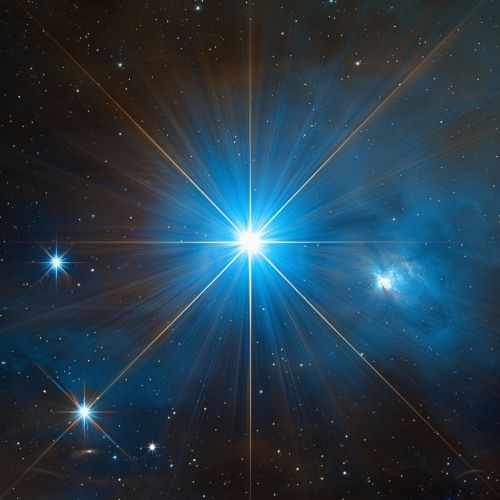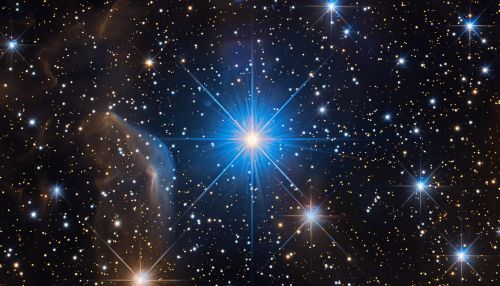Blue Giant
Introduction
A "Blue Giant" is a type of star that is characterized by its high temperature and luminosity. These stars are typically found in the upper left portion of the Hertzsprung-Russell diagram, a graphical tool that astronomers use to classify stars based on their luminosity, spectral type, color, temperature, and evolutionary stage. Blue giants are massive stars that have exhausted the hydrogen in their cores and have moved off the main sequence. They are often short-lived, burning through their nuclear fuel at a rapid rate. This article delves into the properties, formation, lifecycle, and significance of blue giants in the context of stellar evolution.
Properties
Physical Characteristics
Blue giants are known for their immense size and brightness. They typically have a mass ranging from 10 to 100 times that of the Sun and a radius that can be up to 20 times larger. Their surface temperatures range between 10,000 to 50,000 Kelvin, which gives them their characteristic blue color. The luminosity of blue giants can be tens of thousands to hundreds of thousands of times greater than that of the Sun.


Spectral Classification
Blue giants fall into the spectral classes O and B. These classes are defined by the star's temperature and the presence of specific absorption lines in their spectra. O-type stars are the hottest and most massive, with temperatures exceeding 30,000 Kelvin. B-type stars are slightly cooler, with temperatures ranging from 10,000 to 30,000 Kelvin. The spectral lines of ionized helium and hydrogen are prominent in these stars.
Luminosity and Magnitude
The luminosity of blue giants is a direct consequence of their high mass and temperature. According to the Stefan-Boltzmann law, the luminosity of a star is proportional to the fourth power of its temperature and the square of its radius. This means that even a small increase in temperature or radius can result in a significant increase in luminosity. Blue giants have absolute magnitudes ranging from -5 to -10, making them some of the brightest stars in the sky.
Formation
Stellar Birth and Main Sequence
Blue giants originate from massive molecular clouds, regions of space filled with gas and dust. When these clouds collapse under their own gravity, they form protostars. If the protostar accumulates enough mass, it will ignite nuclear fusion in its core, converting hydrogen into helium. This marks the beginning of the star's life on the main sequence, where it will spend the majority of its life.
Evolution Off the Main Sequence
Once a blue giant has exhausted the hydrogen in its core, it leaves the main sequence and enters the giant phase. The core contracts and heats up, causing the outer layers to expand and cool. However, due to their high mass, blue giants do not become red giants like less massive stars. Instead, they may become blue supergiants or even more exotic objects like Wolf-Rayet stars.
Lifecycle
Hydrogen Burning Phase
During the hydrogen-burning phase, blue giants fuse hydrogen into helium via the CNO cycle, a process that is more efficient at higher temperatures. This phase is relatively short-lived, lasting only a few million years, compared to the billions of years for less massive stars.
Helium Burning and Beyond
After the hydrogen in the core is exhausted, the star begins to burn helium into heavier elements like carbon and oxygen. This phase is even shorter, lasting only a few hundred thousand years. The star may go through several more stages of nuclear burning, producing elements up to iron in its core.
End of Life
The lifecycle of a blue giant often ends in a spectacular supernova explosion. When the core can no longer support the weight of the outer layers, it collapses, triggering a violent explosion that disperses the outer layers into space. The remnant core may become a neutron star or, if the mass is sufficient, a black hole.
Significance in Stellar Evolution
Role in Chemical Enrichment
Blue giants play a crucial role in the chemical enrichment of the galaxy. The heavy elements produced in their cores are dispersed into the interstellar medium during supernova explosions. These elements are essential for the formation of planets and life.
Influence on Surrounding Environment
The intense radiation and stellar winds from blue giants can have a significant impact on their surrounding environment. They can trigger the formation of new stars by compressing nearby molecular clouds or, conversely, inhibit star formation by dispersing the gas and dust.
